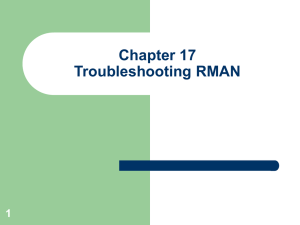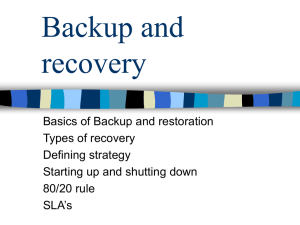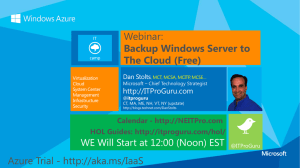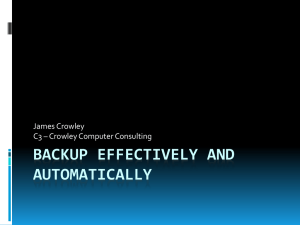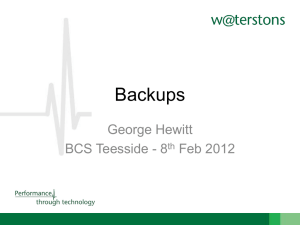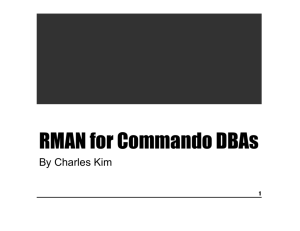The What How and Why of RMAN
advertisement
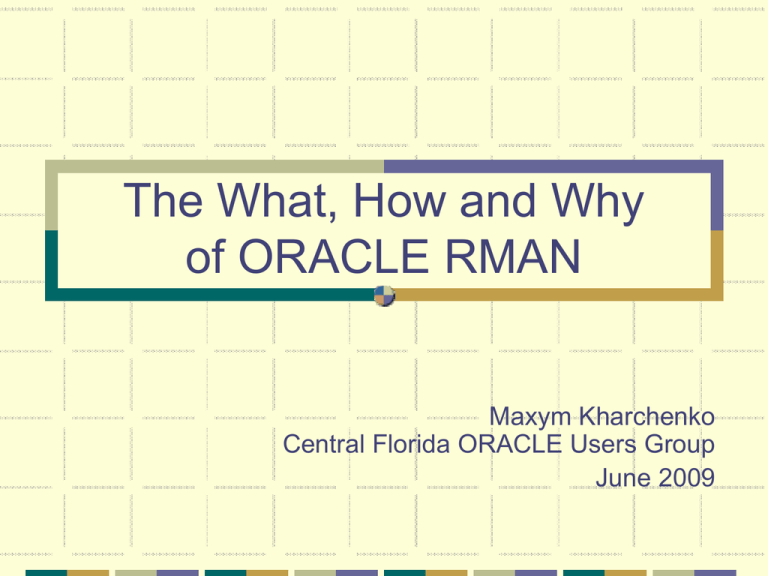
The What, How and Why
of ORACLE RMAN
Maxym Kharchenko
Central Florida ORACLE Users Group
June 2009
Who am I
Maxym Kharchenko, maxym@softcomputer.com
a Scorpio …
Used to be database internals developer
Anyone else heard about: dbVista/Raima/Birdstep/RDM?
Have known RMAN since release 8 … closely …
ORACLE Certified Master
… RMAN was a big part of the exam … shh …
What is it that DBA does ?
DBA is someone, who …
Keeps the database running …
“If your program doesn’t stop producing 10 Gb of archived logs
every minute, the system will die in 30 minutes … Just FYI …”
… Reasonably fast …
“You might think of using WHERE clause in that SQL” …
Protects the data …
“How many tables did you say your script drop by mistake?”
… and keeps it reasonably secure
“Sorry, the CEO asked NOT to make his salary world viewable” …
Etc etc etc
Recover that data OR die!
All DBA responsibilities are important
But NONE is as important as …
Be able to recover data when necessary !
People might (reasonably) tolerate:
System slowness
Lack of security
Even downtime …
But … if you lose production data and CANNOT recover it
you are really, really screwed !
Nobody will care about the reasons
One strike and you are out!
ORACLE Backup and Recovery
are NOT for the average Joe …
-- Backup data files
Get tbs list/exclude not needed
FOR i IN ‘all tablespaces’ DO
ALTER tablespace $I BEGIN BACKUP;
Get the list of tbs files
Copy tbs files
ALTER TABLESPACE $I END BACKUP;
DONE
-- Backup archived logs
Get the list of ARC destinations
Copy archived logs
How to perform a ‘disaster’ recovery
Backup
1
2
3
Backup
4
5
6
7
Backup
8
9 10 11 12 13
Let’s face it –
ORACLE backups and
recoveries are complex …
Making a mistake is easy …
if you do NOT understand what
you are doing …
… and sometimes even
if you do …
Successful database recovery
test means:
A guaranteed future recovery
?
Why DBAs make mistakes
(with backups) ?
There are 2 major reasons:
Junior DBAs the problem is complexity
You need to know a lot and experience a lot
Some things will only come with experience
It is EASY to make a mistake if you don’t know enough …
Senior DBAs the problem is that the process is too mundane
Repeating the same 40 operations over and over is boring
People tend to optimize the work and skip the unnecessary steps
Documentation is often ignored
It is even EASIER to make a mistake if you know too much …
Coming of ‘R-man’
To recover the data in all cases … guaranteed,
you need to:
Know it all
Remember everything
The (sad) conclusion is:
No human will be able to do it …
That is why, we need a ROBOT
The WHAT of RMAN
RMAN Makes Things Simple
ALTER DATABASE BEGIN BACKUP;
Get the list of database files
(optional) Exclude read only/unneeded
Copy database files
Check that copy is successful
ALTER DATABASE END BACKUP;
ALTER SYSTEM SWITCH ARCHIVE LOG CURRENT;
Get the list of ARC destinations
Copy archived logs
Check that copy is successful
ALTER DATABASE BACKUP CONTROLFILE TO …;
Copy controlfile
Copy parameter/spfile/password file
Check that copy is successful
backup full database plus archivelog;
RMAN is a Detail Junkie
EXECUTES:
•
Every single step in the procedure …
•
… Including implied (‘switch that log’) …
REMEMBERS:
•
What backups to keep, remove …
•
Special cases (i.e. KEEP FOREVER)
KEEPS TRACK AND VALIDATES:
•
Is my data recoverable from backups ?
•
Are my backups ‘good’ ?
ADVISES AND MAKES DECISIONS:
•
What to backup ?
•
How to recover ?
RMAN has Advanced Tools
Incremental Backups
Compressed Backups
Encrypted Backups
Block Recovery
Backup Flow Control
Etc …
RMAN Manages Binary Metadata
Backup Repository (”Metadata”)
DB
(“Data”)
Create ‘test’
copy of DB
excluding
historical data
DB Copy
Create logical
standby database
Standby DB
Create a
“pluggable” copy
of tbs “Lab_main”
As of 1 am
yesterday
Lab_main TBS
The HOW of RMAN
RMAN configuration
in a nutshell
Recovery
Catalog
Auxiliary
Database
Auxiliary Channels
RMAN
AUX
Output location
Backup Repository
Disk
Tape
Disk
AND
Tape
Disk
THEN
Tape
Target
Database
Channels
RMAN backup – Data Copies
RMAN Backup as copy
Recovery from copy
A
A
A
A
B
B
B
B
Cataloging external copy
A
B
Copy switch
A
A
B
B
RMAN backup – Backupsets
1.
Backup as backupset
Backups can be smaller:
•
A1 A2 A3
B1 B2 B3
A1
B3 A3
2.
(some) Backups can be faster:
•
A2
B1 B2
3.
Recovery from backupset
A1 A2 A3
B1 B2 B3
A1
A2
B3 A3
B1 B2
Zero block, UNDO optimization
System can be less affected
•
6.
Incremental vs. ARC
(some) Backup operations
can be optimized
•
5.
Incremental with B.C.T.
(some) Recoveries can be faster:
•
4.
Incremental, Compressed
Native RMAN, MINIMIZE LOAD
Can backup directly to “tape”
Full backup and recovery will be slower
How to be Incremental
Full
Incremental cumulative
Sunday
Sunday (level 0)
Monday
Mon (1c)
Tuesday
Tue (1c)
Wednesday
Wed (1c)
Thursday
10
Thu (1c)
10
5
5
Incremental
13
7
Incrementally updated
Sunday (level 0)
Sunday (copy/level 0)
Mon (1)
+
= +
=
Mon (1)
Tue (1)
Monday (copy/level 0)
Wed (1)
Thu (1)
11
11
15
Tue (1)
Tuesday (copy/level 0)
8
12
6
Speeding Up
Incremental Backups
1 2 3 4 5 6 7 8 9 10 11 12
Datafile 5
Backup
Repository
Incremental backup - Regular
1 2 3 4 5 6 7 8 9 10 11 12
4
Datafile 5
B.C.T log
10
Incremental backup – with block change tracking
Backup
Repository
RMAN – Making a Backup
RMAN> run {
allocate
parms
allocate
parms
channel ch1 type sbt
'ENV=(TDPO_OPTFILE=/opt/tsm/tdpo.opt)' rate=100M
channel ch2 type sbt
'ENV=(TDPO_OPTFILE=/opt/tsm/tdpo.opt)' rate=100M;
backup incremental level 0 database format '%d_s%s_p%p_%T.bkpdf';
backup archivelog all format '%d_s%s_p%p_%T.bkpal';
delete noprompt archivelog all until time "sysdate-2/24";
backup current controlfile format '%d_s%s_p%p_%T.bkpcf';
release channel ch1;
release channel ch2;
}
RMAN> backup incremental level 0 database plus archivelog;
RMAN – The Beauty
of Stored Parameters
RMAN> show all;
CONFIGURE RETENTION POLICY TO RECOVERY WINDOW OF 7 DAYS;
CONFIGURE BACKUP OPTIMIZATION ON;
CONFIGURE DEFAULT DEVICE TYPE TO 'SBT_TAPE';
CONFIGURE CONTROLFILE AUTOBACKUP ON;
CONFIGURE CONTROLFILE AUTOBACKUP FORMAT FOR DEVICE TYPE SBT_TAPE
TO 'autocf_%d_%F';
CONFIGURE DEVICE TYPE 'SBT_TAPE' PARALLELISM 2
BACKUP TYPE TO BACKUPSET;
CONFIGURE CHANNEL DEVICE TYPE 'SBT_TAPE'
PARMS 'ENV=(TDPO_OPTFILE=/opt/tsm/tdpo.opt)'
FORMAT '%d_s%s_p%p_%T.bkpset';
CONFIGURE CHANNEL 1 TYPE 'SBT_TAPE' RATE 100M;
CONFIGURE CHANNEL 2 TYPE 'SBT_TAPE' RATE 100M;
Disk or Tape ?
RMAN> backup device type DISK full database plus archivelog;
RMAN> backup device type SBT full database plus archivelog;
Sunday:
RMAN> backup device type SBT incremental level 0 database
plus archivelog;
Monday:
RMAN> backup device type DISK incremental level 1 database;
RMAN> backup device type SBT archivelog all;
RMAN> backup incremental level 0 database plus archivelog;
RMAN> backup recovery area;
RMAN - Recovering Your Data
set dbid 2226857552;
startup force nomount
restore spfile from autobackup;
shutdown immediate
startup nomount
restore controlfile from autobackup;
alter database mount;
# (optional): catalog start with '…';
# Find latest available SCN, i.e. from v$archived_log
restore database until scn 1234567;
recover database until scn 1234567;
alter database open resetlogs;
RMAN> restore spfile from '/ora05/flash/DEV10/autobackup/
2008_12_21/o1_mf_s_674071460_4nxlvpdk_.bkp';
RMAN> restore controlfile from autobackup
db_recovery_file_dest='/ora05/flash' db_name='orcl';
Block Recovery
# First of all - find which blocks are corrupted
1. Alert log
2. RMAN> backup validate check logical datafile N;
SQL> SELECT * FROM v$database_block_corruption;
3. RMAN> backup check logical datafile N;
4. UNIX> dbv data_file
# Then, repair it like this:
RMAN> blockrecover datafile X block Y;
# Or, like this:
RMAN> blockrecover corruption list;
RMAN – How to
Maintain Backups
Remove/Create
Flash Recovery Area
Repository
Repository
Database
Database
“Tape”
Recovery Window
“Tape”
Flash Recovery Area + TDP
Repository
Repository
Database
Database
“Tape”
“Tape”
FRA Sizing Considerations
Remove/Create
Repository
Database
“Tape”
Flash Recovery Area
Repository
Database
“Tape”
FRA – How Large ?
FRA size depends on:
FRA Components
Level 0
Level 1
Flashback Archivelog
FRA: How backup method can affect size
Database
FRA: Disk
FRA: Disk THEN Tape
FRA: Compressed backups
FRA: Level 0 - TAPE, Level 1 - DISK
Size and volatility
of FRA components
Backup Retention
Backup Method
Is your database recoverable ?
RMAN> list backup of database summary;
RMAN> list backup of database by file;
RMAN> report need backup database;
RMAN> report unrecoverable database;
RMAN> restore database preview;
RMAN> recover database test;
RMAN> crosscheck backup;
RMAN> crosscheck copy;
RMAN> backup incremental level 0 check logical database;
SQL> SELECT * FROM v$database_block_corruption;
RMAN> restore database validate check logical;
SQL> SELECT * FROM v$database_block_corruption;
RMAN - Managing Your
Binary Metadata
Backup Repository (”Metadata”)
DB
Aux DB
(“Copy”)
Aux DB
TTS TBS
Aux DB
TTS TBS
duplicate target database
to testdb skip tablespace tbs1
until time ‘sysdate-1’
logfile
group 1 (‘/testdb/redo01.arc’)
size 100M reuse,
group 2 (‘/testdb/redo01.arc’)
size 100M reuse;
transport tablespace lab
tablespace destination '/tbs'
auxiliary destination '/aux'
until time 'sysdate-1';
recover tablespace users, tools
auxiliary destination '/aux'
until time 'sysdate-1';
RMAN Extras
Database command console
ASM data manager
Datafile platform conversion
Script processor
The WHY of RMAN
Why use RMAN?
RMAN utility:
Can simplify many backup and recovery operations
Performing them faster and, in many cases, better than ‘regular’
backup tools
Let’s you do some cool things with ORACLE
Helps avoid mistakes
But most importantly,
RMAN allows a DBA to be LAZY (in a good way)
And spend your valuable time on other cool things in ORACLE
Because, let’s admit it … backups ARE …
… boring … ;-)
Any Questions ?

